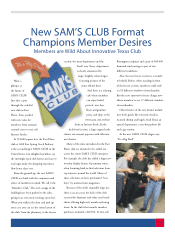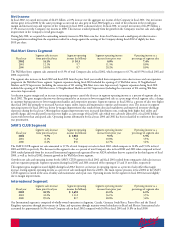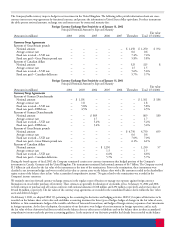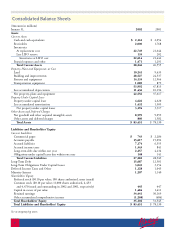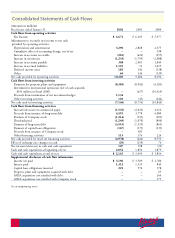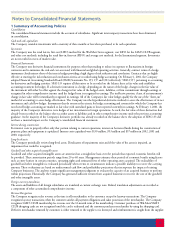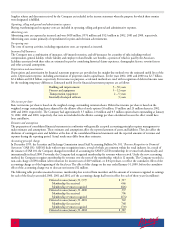Walmart 2002 Annual Report Download - page 21
Download and view the complete annual report
Please find page 21 of the 2002 Walmart annual report below. You can navigate through the pages in the report by either clicking on the pages listed below, or by using the keyword search tool below to find specific information within the annual report.
19
other comprehensive income until the hedged item is recognized in earnings. The ineffective portion of an instrument’s change in fair value will be
immediately recognized in earnings. All of the Company’s fair value hedges qualify for the use of the “short-cut” method of accounting to assess hedge
effectiveness. The Company uses the hypothetical derivative method to assess the effectiveness of its net investment and cash flow hedges. Instruments
that do not meet the criteria for hedge accounting or contracts for which we have not elected hedge accounting are marked to fair value with unrealized
gains or losses reported currently in earnings. Fair values are based upon management’s expectation of future interest rate curves and may change based
upon changes in those expectations.
Impairment of Assets
We periodically evaluate long-lived assets and acquired businesses for indicators of impairment. Management’s judgements regarding the existence
of impairment indicators are based on market conditions and operational performance. Future events could cause management to conclude that
impairment indicators exist and that the value of long-lived assets and goodwill associated with acquired businesses is impaired.
Revenue Recognition
We recognize sales revenue at the time a sale is made to the customer, except for the following types of transactions. Layaway transactions are recognized
when the customer satisfies all payment obligations and takes possession of the merchandise. We recognize SAM’S CLUB membership fee revenue over
the 12-month term of the membership. Customer purchases of Wal-Mart/SAM’S CLUB shopping cards are not recognized until the card is redeemed
and the customer purchases merchandise using the shopping card. Defective merchandise returned by customers is either returned to the supplier or is
destroyed and reimbursement is sought from the supplier. Supplier allowances and discounts received by the Company are included in the income
statement when the purpose for which those monies were designated is fulfilled.
Insurance/Self-Insurance
We use a combination of insurance, self-insured retention, and/or self-insurance for a number of risks including workers’ compensation, general liability,
vehicle liability and employee-related health care benefits, a portion of which is paid by the Associates. Liabilities associated with the risks that we retain
are estimated in part by considering historical claims experience, demographic factors, severity factors and other actuarial assumptions. The estimated
accruals for these liabilities could be significantly affected if future occurrences and claims differ from these assumptions and historical trends.
For a complete listing of our significant accounting policies, please see Note 1 to our consolidated financial statements that appear after this discussion.
Liquidity and Capital Resources Cash Flows Information
Our cash flows from operating activities were $10.3 billion in fiscal 2002, up from $9.6 billion in fiscal 2001. In fiscal 2002, we invested $8.4 billion in
capital assets, paid dividends of $1.2 billion, paid $1.2 billion to repurchase Company stock, received $1.1 billion from the termination of certain net
investment hedges, received $4.6 billion from the issuance of long-term debt and paid $3.5 billion in the repayment of long-term debt at its maturity.
Company Stock Purchase and Common Stock Dividends
During fiscal 2001, the Company announced plans to increase its existing common stock repurchase program by $1 billion, resulting in a total
authorization of $3 billion. During fiscal 2002, the Company repurchased 24.5 million of its common shares for a total approximate amount of
$1.2 billion. In March 2002, the Company’s Board of Directors reset the common stock repurchase program authorization so that the Company may
make future repurchases of its stock of up to $3 billion. The Company paid dividends totaling $0.28 per share in fiscal 2002. In March 2002, the
Company increased its dividend 7% to $0.30 per share for fiscal 2003. The Company has increased its dividend every year since it first declared a
dividend in March 1974.
Contractual Obligations and Other Commercial Commitments
The following tables set forth certain information concerning our obligations and commitments to make future payments under contracts, such as debt
and lease agreements, and under contingent commitments.
Payments due by period
Contractual obligations Less than 1 – 3 4 – 5 After
(in millions) Total 1 year years years 5 years
Long-term debt $ 17,944 $ 2,257 $ 5,448 $ 2,939 $ 7,300
Commercial paper 743 743 0 0 0
Capital lease obligations 5,514 425 847 828 3,414
Non-cancelable operating leases 8,054 623 1,188 1,112 5,131
Total contractual cash obligations $ 32,255 $ 4,048 $ 7,483 $ 4,879 $ 15,845
Amount of commitment expiration per period
Other commercial commitments Less than 1 – 3 4 – 5 After
(in millions) Total 1 year years years 5 years
Lines of credit $ 3,811 $ 1,561 $ 0 $ 2,250 $ 0
Informal lines of credit 694 694 0 0 0
Trade letters of credit 1,578 1,578 0 0 0
Standby letters of credit 743 743 0 0 0
Other 273 147 0 0 126
Total commercial commitments $ 7,099 $ 4,723 $ 0 $ 2,250 $ 126





